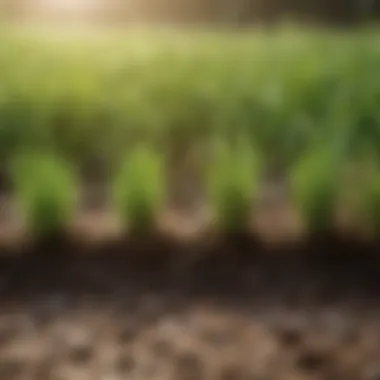Mastering Watering Techniques for Zoysia Grass


Intro
Zoysia grass is a popular choice for lawns due to its durability and aesthetic appeal. However, successful establishment of Zoysia grass seed hinges on effective watering techniques. Proper hydration ensures seed germination and healthy growth, particularly in the critical early stages. This guide will provide an in-depth look at the best practices for watering Zoysia grass seed, discussing essential techniques, timing, and environmental factors that impact lawn vitality.
Current Trends in Agriculture and Horticulture
With the advancement of technology and an increasing awareness of sustainable practices, the agriculture industry is evolving.
Overview of Recent Innovations
In recent years, innovative irrigation systems have gained traction among turf managers. Smart irrigation controllers can tailor watering schedules based on real-time weather data. Some systems even measure soil moisture, allowing for precise watering. These advancements promote the efficient use of water, conserving this vital resource while ensuring optimal growth for Zoysia grass.
Sustainable Practices Gaining Popularity
Sustainability is a growing focus in horticulture. Many consider using rainwater collection methods to irrigate their lawns. This not only reduces water costs but also lessens dependence on municipal sources. Additionally, organic fertilizers are becoming popular, promoting a healthy lawn ecosystem.
Essential Watering Techniques
Watering Zoysia grass seed properly is essential. Here are several techniques to consider:
- Deep Watering: It's better to water deeply less frequently than to sprinkle lightly every day. Deep watering allows roots to grow deeper, which strengthens the grass.
- Morning Watering: Early morning watering helps to reduce evaporation. This means the grass can absorb water effectively before warmer temperatures arrive.
- Moisture Management: Using mulch can retain soil moisture, minimizing the need for frequent watering.
Timing and Frequency
The timing and frequency of watering Zoysia grass seed play a crucial role in lawn care. Here is a breakdown:
- First Two Weeks: Watering should occur daily to keep the soil consistently moist.
- After Germination: Once seedlings appear, you can reduce frequency. Water every two or three days, depending on the weather.
- Growing Season: During hot months, adjust your watering schedule, aiming for 1 to 1.5 inches per week.
Environmental Factors
Environmental elements profoundly impact watering needs. Consider:
- Temperature: Higher temperatures increase evaporation and may necessitate more frequent watering.
- Humidity: In high humidity, less frequent watering may suffice as moisture is retained in the air.
- Soil Type: Sandy soils drain quickly and require more frequent watering compared to clay soils, which retain moisture for longer.
This information emphasizes the significance of tailored watering practices to promote Zoysia grass seed growth effectively.
Finale
Understanding the nuances of watering Zoysia grass seed is dead essential for achieving a lush and vibrant lawn. With varying environmental factors, the correct techniques and appropriate timing will make a significant difference. Cultivating knowledge about these practices will equip both novice and experienced turf managers to foster the health and vitality of their Zoysia lawns, generating rewarding results throughout the growing season.
Foreword to Zoysia Grass
Zoysia grass is a popular choice for lawns, especially in warmer climates. It is favored for its ability to withstand heat, drought, and foot traffic. The significance of understanding Zoysia grass goes beyond mere aesthetics; it plays a crucial role in lawn care management. Knowing the characteristics and benefits of Zoysia grass sets the foundation for successful cultivation and maintenance. This section provides an overview of what makes Zoysia grass unique and beneficial for homeowners and turf managers alike.
Characteristics of Zoysia Grass
Zoysia grass is a warm-season perennial grass, belonging to the Zoysia genus. Its growth habit is characterized by dense and leafy growth, which creates a robust turf. The leaf blades are typically narrow, measuring about 1/8 inch wide and can grow 1 to 3 inches long. Zoysia can thrive in various soil types but prefers well-drained, fertile soils. Once established, it creates a thick mat that effectively chokes out weeds, making it easier to manage.
Another notable characteristic is its slow growth during cooler months, meaning it enters dormancy in colder climates. In contrast, it significantly speeds up growth during the warm season, showcasing a vibrant green hue. Zoysia grass also has a high tolerance for foot traffic, allowing it to recover well from wear and tear. Moreover, it requires less frequent mowing due to its growth pattern, providing a lower maintenance option for lawn care.
Benefits of Growing Zoysia Grass
Growing Zoysia grass offers multiple benefits that enhance the experience of lawn care. Here are some advantages to consider:
- Drought Resistance: Zoysia grass develops deep root systems, allowing it to tolerate prolonged dry spells. This characteristic is particularly advantageous in regions that experience low rainfall.
- Weed Suppression: Its dense growth habit makes it an effective competitor against weeds, reducing the need for herbicides and other interventions.
- Low Maintenance: Once established, Zoysia requires less maintenance compared to other grass types. Its slower growth means less frequent mowing, and its tolerance to various soil conditions minimizes the need for extensive amendments.
- Aesthetic Appeal: With its lush green appearance, Zoysia grass enhances the visual appeal of lawns, gardens, and landscapes.
- Versatility: It can be used in various settings, from residential lawns to commercial landscapes, adapting well to many conditions.
Understanding Zoysia grass is not only essential for selecting the right type of grass for one's lawn but also for learning how to adequately manage its growth and health. As this article proceeds, readers will gain insightful knowledge about the best practices for watering Zoysia grass seed, ultimately fostering healthier and more vibrant lawns.


Understanding the Germination Process
Understanding the germination process is essential for anyone growing Zoysia grass. This process is the gateway through which the grass seeds develop into strong and healthy plants. Knowing the timeline and factors that influence germination helps turf managers and enthusiasts foster optimal growth conditions. This section clarifies the critical aspects of germination that directly impact lawn vitality.
Seed Germination Timeline
The timeline for Zoysia grass seed germination can vary. Generally, it takes about two to three weeks for Zoysia seeds to germinate under favorable conditions. However, a few elements contribute to this timeline:
- Temperature: Optimal soil temperatures for germination are between 65°F and 70°F (18°C to 21°C). Cooler conditions can significantly delay germination, while warmer temperatures may accelerate it.
- Moisture: Adequate moisture is necessary. If the soil is too dry or overly saturated, germination can be hindered.
- Seed Quality: High-quality seeds have better germination rates compared to older or lower-quality seeds. Proper storage conditions before seeding also influence viability.
Understanding this timeline allows for better planning and execution of watering strategies, ensuring seeds receive the moisture they require within the critical germination period.
Factors Affecting Germination
Many factors influence the germination of Zoysia grass seeds:
- Soil Condition: Well-aerated, nutrient-rich soil encourages germination. Compacted or poor-quality soil can hinder root development.
- pH Levels: The soil's pH should ideally range from 6.0 to 7.0. Acidic or alkaline soils can negatively affect seed viability.
- Sunlight: Although Zoysia grass can tolerate shade, full sun promotes vigorous growth during the germination phase.
- Watering Practices: Consistent and appropriate watering keeps the soil moist but not waterlogged, crucial for seed development.
By understanding these factors, one can create an environment that maximizes germination potential.
Proper management of these elements significantly enhances the likelihood of successful seed germination and establishes a vibrant Zoysia lawn.
Importance of Water in Seed Establishment
Water is one of the most critical elements in the establishment of Zoysia grass seeds. Proper watering supports seed germination, root development, and overall lawn health. The term seed establishment refers to the successful transition from seed to a fully grown plant. During this phase, water acts as a catalyst for various biological processes.
Role of Moisture in Germination
Moisture is essential for Zoysia grass seed germination. When seeds are buried in the soil, they wait for the right conditions to begin the germination process. The presence of adequate moisture activates enzymes that start the metabolic processes critical for germination. Generally, Zoysia grass seeds require a minimum moisture level in the topsoil to sprout. This moisture should be consistent in the early days, as seeds are particularly vulnerable to fluctuations in water availability.
As the seeds absorb water, they swell and break their protective coating. This absorption leads to the formation of the root shoot, which is crucial for anchoring the plant in the soil. Moreover, moisture allows nutrients in the soil to become available to the emerging seedling. Without sufficient water, Zoysia grass seeds may become dormant or cease the germination process altogether.
Consequences of Inadequate Watering
Insufficient watering during the seed establishment phase can lead to several negative outcomes. The most imminent concern is seed dormancy. Dormant seeds do not germinate and will simply wait for better conditions, which effectively prolongs the wait for a lush lawn.
In situations of severe drought, seeds may die before they ever sprout. This loss can lead to bare patches in the lawn and uneven growth. Such scenarios can require reseeding and additional costs, not to mention the disappointment.
In addition to seed loss, inadequate watering can impede root development. If young grass plants do not receive enough water, their roots stay shallow and weak. Shallow roots leave these plants vulnerable to environmental stressors, such as heat and drought during summer months. Without strong root systems, Zoysia grass can struggle to thrive, resulting in poor turf quality.
In summary, water is a vital component in the establishment of Zoysia grass seeds. Comprehending its role allows for better practices in lawn care. Failing to provide adequate moisture can lead to death or weakened plants, emphasizing the importance of proper watering techniques.
Optimal Watering Techniques
Effective watering techniques are crucial for establishing and maintaining Zoysia grass. Proper methods not only ensure seed germination but also contribute to the overall health of the lawn. Choosing the right watering technique can influence moisture levels, ultimately leading to vigorous growth and resilience. There are several common methods to apply water, each with distinct characteristics, advantages, and disadvantages that need considering to achieve the best results.
Methods of Water Application
Using Sprinklers
Sprinklers provide a convenient way to distribute water evenly across a large area. Their adjustable settings make it possible to cover various lawn shapes and sizes efficiently. This method is popular because it simulates rainfall, promoting even moisture distribution. One key characteristic of using sprinklers is the ability to automate the process. By setting a timer, one can ensure consistent watering, especially beneficial for expansive Zoysia grass areas where manual watering may be impractical.
However, there are some disadvantages as well. Wind can disrupt the distribution of water, leading to uneven coverage. Also, excessive watering may occur if not monitored, which could result in waterlogged soil.
Hand Watering
Hand watering provides a more personalized approach to ensuring the grass receives the right amount of moisture. This method allows for direct observation of the lawn condition, giving the opportunity to adjust water application as necessary. One notable advantage of hand watering is the control over water amounts, helping to minimize waste.
Yet, it can be time-consuming and labor-intensive, particularly for larger areas. Watering by hand is also less effective for ensuring uniform moisture distribution compared to other methods.


Drip Irrigation
Drip irrigation represents a highly efficient watering technique that delivers water directly to the root zone of the grass. This method reduces water wastage and improves soil moisture retention. One specific aspect of drip irrigation is its ability to operate with low-pressure systems, making it suitable for various types of landscapes.
Its significant advantage is the precise and targeted approach to watering. However, setting up a drip system can be costly and complicated initially, which might not be ideal for all homeowners. Regular maintenance is also required to prevent clogging of the emitters.
Watering Equipment Recommendations
When selecting watering equipment, consider the size of the lawn, budget, and personal preferences. For sprinklers, high-efficiency models with timers can be advantageous. For hand watering, a quality hose and nozzle should be functional and easy to manage. For those considering drip irrigation, investing in a reliable system with adjustable emitters is recommended.
Timing and Frequency of Watering
The timing and frequency of watering play a crucial role in the successful establishment of Zoysia grass. Understanding when and how often to water can significantly influence the germination process and the overall health of your lawn. Proper timing ensures that the seeds receive sufficient moisture without the risk of overwatering, which can lead to disease or poor growth. Additionally, establishing a consistent watering routine will help develop a resilient lawn that can thrive in various conditions.
Initial Watering After Sowing
After sowing Zoysia grass seeds, the initial watering is vital. This first watering should take place immediately after planting. It helps to settle the soil and ensures good contact between the seeds and the soil. This action creates a conducive environment for moisture retention, which is essential for germination.
It is important to note that the soil should be kept consistently moist during the germination period. Ideally, you should aim to water the area lightly. Using a fine spray setting on your sprinkler can help distribute the water evenly without displacing the seeds. It is recommended to water thoroughly but gently to prevent soil compaction or seed movement.
Establishing a Watering Schedule
Once the initial watering has been done, establishing a watering schedule is crucial. Newly germinated Zoysia grass requires frequent watering. In general, you should water at least once a day for the first 7 to 14 days after sowing. The goal is to maintain a moist layer of soil where the seeds are planted. However, you should avoid excessive watering that could lead to puddles or run-off.
As the seedlings begin to grow and establish themselves, the frequency can be adjusted. Typically, watering can become less frequent, transitioning to every other day or even every third day, depending on the weather conditions. Here are some guidelines to help with scheduling:
- Check Soil Moisture: Stick your finger about an inch into the soil. If it feels dry, it is time to water.
- Consider the Weather: Hot sunny days may require more frequent watering than cool or cloudy days.
- Monitor Seedlings: Keep an eye on the grass. If you notice any signs of stress, adjust your schedule accordingly.
Adjusting Watering to Environmental Conditions
In the realm of Zoysia grass cultivation, understanding how to adjust watering practices based on environmental conditions is paramount. This adaptation ensures that the grass seed receives the right amount of moisture, promoting optimal growth and a robust lawn. Several factors influence the moisture needs of Zoysia grass, including weather patterns and soil characteristics.
Influence of Weather on Water Needs
Weather plays a crucial role in determining the watering requirements of Zoysia grass. Different seasons bring varied temperatures, humidity levels, and precipitation that directly affect the soil moisture.
- Rainfall: In periods of ample rainfall, the need for additional watering decreases. Too much water can lead to waterlogged soil, which harms root development.
- Temperature: High temperatures lead to increased evaporation rates, requiring more frequent watering. During extremely hot spells, you may need to supplement natural rainfall to maintain adequate moisture levels.
- Humidity: High humidity can slow down evaporation, meaning less frequent watering might be necessary.
Each of these factors should be closely monitored, as they can fluctuate rapidly, altering watering needs significantly. Investing time in observing weather forecasts and patterns pays off in the long term by conserving both water and energy.
Soil Characteristics and Water Retention
The ability of soil to retain moisture is another critical consideration when watering Zoysia grass. Different soil types vary greatly in their water retention capabilities, impacting how often and how much water is needed.
- Sandy Soil: This type drains quickly and often requires more frequent watering since it does not hold moisture effectively.
- Clay Soil: On the contrary, clay soils retain water but can become compacted, leading to drainage issues. Overwatering can easily occur in such conditions facilitating root rot.
- Loamy Soil: This is often considered ideal for grass due to its balanced ability to retain moisture while also draining well, allowing for a more even watering approach.
When analyzing soil characteristics, consider performing a simple soil test. This can provide insights into drainage capabilities and help in deciding the watering strategy.
Ensuring that the soil is prepped correctly can significantly enhance the effectiveness of your watering efforts.
Signs of Overwatering and Underwatering
Correctly managing water levels is vital for Zoysia grass seed development. The right amount of moisture can promote healthy growth, while both excess and insufficient watering can lead to serious issues. Recognizing the signs of overwatering and underwatering allows you to adjust your practices effectively. Mismanagement in this area can quickly lead to significant setbacks in lawn health and vitality. This section details how to identify these issues, enabling proactive maintenance of Zoysia grass.
Identifying Overwatering
Overwatering can seriously damage Zoysia grass seeds. It suffocates the roots and can lead to fungal diseases. Here are key indicators:


- Soil Saturation: If the soil feels muddy or is pooling, it is a sign of excessive water.
- Brown Patches: Surprisingly, grass can turn brown even when there is too much water, often caused by root rot.
- Wilting Leaves: This might seem counterintuitive, but overwatered grass may exhibit wilting, as roots are unable to absorb oxygen.
- Fungus Growth: Observe if mushrooms or mold appear, which thrive in overly moist conditions.
To manage overwatering, establish a consistent watering schedule and examine soil drainages. Aerating the soil can help to alleviate problems caused by excessive moisture.
Recognizing Underwatering
Underwatering presents its own set of problems. Insufficient moisture can stunt growth or even kill grass. Here are some signals of underwatering:
- Dry Soil: Check the top inch of soil. If it is dry and crumbly, the grass is likely underwatered.
- Leaf Curling: Leaves may curl or fold, indicating stress from lack of moisture.
- Scorched Grass: Yellowing or browning blades are clear signs. Grass can develop a burnt look when it’s not receiving sufficient water.
- Footprint Test: If footprints remain imprinted on the lawn for a while, the grass is probably lacking water.
To rectify underwatering, ensure you follow a proper watering schedule, especially during dry spells or high temperatures. Monitoring weather conditions can guide you in adjusting your watering habits appropriately.
Tip: Regular soil testing can provide insights into moisture levels, ensuring both overwatering and underwatering are effectively avoided.
Long-Term Watering Practices for Zoysia Grass
Understanding the long-term watering practices for Zoysia grass is crucial for maintaining a vibrant and healthy lawn. Zoysia grass, known for its resilience and drought tolerance, requires a systematic approach to watering that adapts over time. The intent of long-term practices is to support the grass's growth, strengthen its roots, and reduce water wastage.
Regularly assessing the watering needs of Zoysia grass depending on seasonal changes and environmental factors is vital. Proper long-term watering helps to establish a robust lawn that can withstand varying conditions. A well-watered Zoysia grass promotes better health, enhances soil structure, and minimizes pests and diseases.
Effective long-term watering practices also improve water-use efficiency, an essential consideration as water resources become limited. Here, we explore how to adapt watering practices seasonally and focus on water conservation techniques.
Adapting to Seasonal Changes
Seasonal changes affect the watering needs of Zoysia grass significantly. During spring, the grass begins to wake from dormancy and needs ample moisture to support new growth. A frequency of watering two to three times per week is typically effective, depending on rainfall.
In the summer, when temperatures rise, the grass may require more water. Implementing deep, infrequent watering practices ensures that the grass roots grow deeply, enhancing drought resistance. Aim for 1 to 1.5 inches of water per week during this period, adjusting based on rainfall and soil moisture levels.
As temperatures decrease in fall, reduce the frequency of watering. The grass slows down its growth rate and uses less water. Monitor rainfall, and consider watering only if the natural precipitation does not meet the grass's needs.
During winter, when the grass goes dormant, avoid watering unless there are prolonged dry spells. Zoysia grass does not need water in the colder months, and overwatering can be detrimental.
It is important to observe your lawn and adjust as necessary. Soil moisture can be monitored using soil moisture meters or by hand. This ensures the right balance of water without damaging the grass.
Water Conservation Techniques
Water conservation is essential for long-term lawn health and sustainability. Implementing effective strategies not only preserves water resources but also lowers utility costs. Here are some practical techniques:
- Use a Rain Barrel: Collect rainwater to irrigate your lawn. This reduces reliance on municipal water supply and is environmentally friendly.
- Mulching: Apply organic mulch around the grass to cover soil. This helps retain moisture, reduces evaporation, and controls weeds.
- Smart Sprinkler Systems: Consider automated sprinkler systems that adjust according to the weather conditions. Smart systems can detect rainfall and skip watering when unnecessary.
- Deep Watering: Watering deeply but infrequently encourages deep root growth. This condition makes the grass resilient to drought.
- Soil Testing: Conduct soil tests periodically to understand nutrient levels and moisture-holding capacity. This helps create a tailored watering plan that optimizes the use of water.
Implementing these water conservation techniques can enhance the lawn's resilience and contribute positively to the environment. With thoughtful practice, Zoysia grass can thrive under optimal conditions while using minimal water resources.
Efficient watering practices not only lead to a healthier lawn but also foster responsible stewardship of water resources.
The End and Key Takeaways
This section emphasizes the vital role that proper watering plays in the successful establishment and maintenance of Zoysia grass. Understanding the nuances of watering can significantly influence seed germination, growth rates, and overall lawn health. Each aspect of the watering process, from the initial application to long-term practices, contributes to the vibrancy of a Zoysia lawn.
Effective watering is not just about providing water; it involves knowing when, how much, and which method aligns best with local conditions. The guidelines established in previous sections can help reduce the likelihood of issues like overwatering and underwatering. Proper watering techniques encourage deep root systems that can better withstand heat and drought conditions.
The benefits of mastering watering for Zoysia grass include:
- Faster Germination: Ensuring consistent moisture can cut down on the time it takes for seeds to sprout.
- Improved Resilience: A well-watered lawn establishes stronger roots, making it more resistant to environmental stress.
- Reduced Disease Risks: Proper moisture levels lower the risk of diseases associated with overly wet or dry conditions.
This section synthesizes key points discussed throughout the article and serves as a reminder of the critical nature of water management in turf practices. Proper education on this topic informs better decision-making for farmers and enthusiasts aiming for a healthy lawn.
Summary of Best Practices
- Maintain consistent moisture, especially during germination.
- Water early in the morning to reduce evaporation and fungal issues.
- Test soil moisture levels to avoid over or underwatering.
- Utilize efficient watering systems like drip irrigation when possible.
- Be observant of environmental changes and adjust watering schedules accordingly.
Future Considerations for Turf Management
As we look to the future, several key factors come into play for sustainable agronomy practices regarding Zoysia grass:
- Climate Adaptation: As global climates shift, understanding how humidity and temperature affect grass requirements is vital.
- Water Source Management: Ensuring a reliable water supply while conserving resources will be crucial.
- Technological Integration: Advancements in smart irrigation systems can optimize watering schedules, responding to immediate environmental needs.



